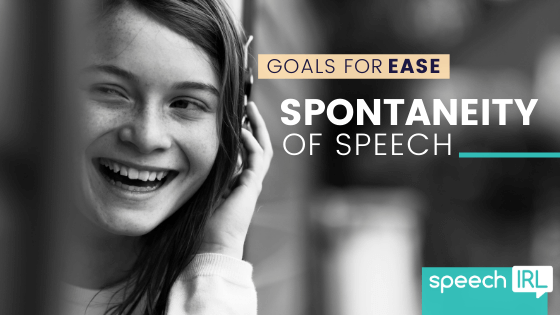In our previous posts on education and empowerment goals for speech therapy, we discussed activities to work on as alternatives to speech goals. You may expect this post will finally get to some new activities that actually focus on fluency—but alas, not quite. Ease, our final E in our 3Es model actually has little to do with fluency of speech. Aspects of ease include spontaneous speech, stuttering easier with less tension, and awareness of the speech mechanism.
Spontaneity ≠ Fluency
Chris Constantino1 defines spontaneous speech as speech that is characterized by little premeditation, is effortless, and is meaningful. This is fundamentally different from fluency. Disfluent speech can be highly spontaneous and fluent speech can be effortful. Spontaneity, not fluency, decreases the adverse impact of stuttering on people’s lives.
But they’re coming in for a fluency disorder, they still need to work on fluency, right?
There are many other, more effective ways to reach easier speech than fluency. Stuttering is a paradoxical disorder. Often, working on fluency leads to more stuttering, while working on stuttering openly often results in increased fluency. You can meet IEP minutes by treating stuttering in a way that is helpful and relevant without targeting fluency. Not only that, you can write evidence-based, IEP-compliant speech therapy goals that do NOT require increased fluency, but instead focus on increased spontaneity of speech.
Writing Goals for Ease
You’ve probably had that client. They’ve had the same IEP goal for years: something like “will maintain fluency 80% of the time.” Year after year, week after week, they either A. fail to meet this goal or B. are unable to generalize it outside of the therapy room.
Better, more attainable goals include:
- Exploring the range of stuttering modification techniques
- Learning about how the speech mechanism works
- Identifying parameters of forward moving speech
- Building awareness of speech behaviors that interfere with fluency
- Understanding secondary behaviors
- Slowing rate and building in pauses
- Improving eye contact
How can I justify this?
These areas can be justified using rationale goal language:
- “To improve communication ability…”
- “To decrease tension in speech…”
- “To improve forward moving speech…”
- “To improve speaking ease…”
- “To increase intelligibility…”
- These areas can be measured using “product delivery” goal language:
- “...by identifying five stuttering modification techniques.”
- “....by identifying two parameters of speech that interfere with their production of forward moving speech.”
- “...by maintaining eye contact during 80% of disfluencies in a monologue”
- “...by monitoring a secondary behavior with 80% accuracy in a monologue”
These goals can be time-bound using deadline goal language:
- “...by the end of the term/semester”
- “...within X weeks/sessions”
The Shortfalls Of Techniques
- They require a lot of effort. Many routes to easier speech encourage effortful fluency: consciously applying a technique in order to increase fluency. However, increased effort decreases spontaneity of speech. It’s often extremely difficult to monitor what you are saying and how you are saying.
- They don’t always work. Techniques are influenced by fear. If I put a balance beam on the floor, would you be able to walk across it? If I put the balance beam one foot off the floor, would you be able to walk across it? What about 50 feet? 100 feet? The motor task doesn’t change, only the fear does. Fear influences motor behavior.
Just because a student stutters, does not mean you need to work on fluency...and why would we, when there is so much MORE?
For more therapy ideas and resources, check out our Teachers Pay Teachers store.
For updates on our stuttering CEU events and clinician trainings, subscribe to our newsletter or follow us on Facebook or Twitter.
- Constantino, C. D., Eichorn, N., Buder, E. H., Beck, J. G., Manning, W. H. (2020). The Speaker’s Experience of Stuttering: Measuring Spontaneity, Journal of Speech, Language, and Hearing Research, 63, 983-1001.

